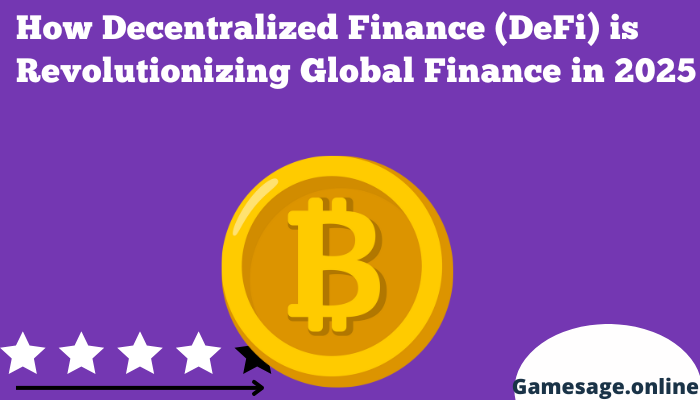In recent years, the financial landscape has witnessed an extraordinary transformation thanks to the rise of Decentralized Finance, or DeFi. This innovative approach leverages blockchain technology to provide open, permissionless, and transparent financial services without relying on traditional intermediaries like banks and brokers. In 2025, DeFi is no longer just a buzzword—it has become a driving force reshaping the global finance ecosystem.
What is Decentralized Finance (DeFi)?
Decentralized Finance, commonly known as DeFi, refers to a new wave of financial applications built on blockchain platforms that operate without central authorities. Instead of trusting banks or financial institutions, DeFi protocols use smart contracts—self-executing agreements encoded on blockchains—to automate and enforce financial transactions transparently and securely.
At its core, DeFi democratizes access to financial services by removing gatekeepers, enabling anyone with an internet connection to participate, regardless of geography or background. Unlike traditional finance, where intermediaries charge fees and impose restrictions, DeFi offers permissionless access, fostering financial inclusion and innovation.
Key Features of DeFi
- Permissionless: Open to anyone without approval.
- Transparency: All transactions are visible on public blockchains.
- Interoperability: Many DeFi applications can seamlessly interact.
- Programmability: Smart contracts automate complex financial operations.
- Decentralization: Reduced reliance on central points of failure.
Why is DeFi Gaining Momentum in 2025?
Several key trends have accelerated DeFi’s rise in 2025:
- Growing Global Financial Inclusion: Over 1.7 billion adults remain unbanked globally. DeFi bridges this gap by offering accessible financial tools without traditional barriers.
- Post-Pandemic Digital Shift: The COVID-19 pandemic accelerated digital adoption. Consumers and institutions alike are embracing decentralized, digital-first financial solutions.
- Advancements in Blockchain Technology: Improvements like Ethereum 2.0, Layer 2 scaling solutions, and alternative blockchains have boosted speed and reduced transaction costs.
- Institutional Interest: Hedge funds, venture capitalists, and major corporations are investing heavily in DeFi infrastructure and protocols.
- Regulatory Clarity Emerging: Governments worldwide are beginning to craft regulations that support innovation while protecting consumers, fostering trust in DeFi.
Popular DeFi Applications and Use Cases
1. Decentralized Exchanges (DEXs)
Decentralized Exchanges like Uniswap, SushiSwap, and PancakeSwap allow users to trade cryptocurrencies directly from their wallets without intermediaries. These platforms operate via liquidity pools and automated market makers (AMMs), enabling efficient, trustless trading with minimal fees and censorship resistance.
2. Lending and Borrowing Platforms
Protocols such as Aave, Compound, and MakerDAO empower users to lend their crypto assets and earn interest or borrow by collateralizing holdings. These services eliminate traditional credit checks and offer instant liquidity globally, often at better rates than conventional banks.
3. Stablecoins
Stablecoins are cryptocurrencies pegged to stable assets like the US Dollar, providing the much-needed stability required for everyday transactions, lending, and savings within DeFi. Popular examples include USDC, DAI, and Tether (USDT).
4. Yield Farming and Liquidity Mining
Users can earn additional tokens or fees by providing liquidity to DeFi pools, incentivizing ecosystem growth. This has become a key way to maximize returns in a competitive market, although it carries risks such as impermanent loss.
5. Synthetic Assets and Derivatives
Platforms like Synthetix enable the creation and trading of synthetic assets representing real-world stocks, commodities, or fiat currencies on the blockchain, expanding access to diverse financial instruments.
Benefits of DeFi Over Traditional Finance
- Accessibility: No banking infrastructure or credit history needed.
- Transparency and Trustlessness: Users retain full control over funds with clear transaction records.
- Lower Costs and Fees: Eliminates expensive intermediaries and overhead.
- Innovation and Customization: Programmable contracts allow tailored financial products.
- Global Reach: Cross-border financial services without delays or conversion issues.
Risks and Challenges Facing DeFi
Despite its promise, DeFi faces significant challenges that users and developers must consider:
- Smart Contract Vulnerabilities: Bugs and exploits can lead to substantial losses.
- Regulatory Uncertainty: Ambiguous laws and potential crackdowns could impact adoption.
- Scalability and High Fees: Networks like Ethereum sometimes suffer from congestion and high gas fees.
- User Experience: Complex interfaces and wallet management remain barriers for newcomers.
- Liquidity Risks: Sudden withdrawals can impact market stability on DEXs and lending platforms.
Institutional Adoption and Integration with Traditional Finance
Institutions are no longer sidelined observers. Major banks, asset managers, and fintech companies are integrating DeFi technologies to enhance their offerings. Hybrid models that combine centralized trust with decentralized features are emerging, allowing smoother onboarding for traditional finance clients while leveraging DeFi’s benefits.
The Future of DeFi: What to Expect Beyond 2025
- Layer 2 Scaling Solutions: Technologies like Optimistic Rollups and zk-Rollups will reduce fees and increase throughput.
- Cross-Chain Interoperability: Bridges between blockchains will enable seamless asset transfers and composability.
- Decentralized Identity (DID): Privacy-focused identity solutions will empower user sovereignty and compliance.
- More Robust Governance: Decentralized Autonomous Organizations (DAOs) will enhance community-driven decision-making.
- Regulatory Maturity: Clear frameworks will promote safer growth and wider adoption.
Conclusion
Decentralized Finance is not just an alternative financial system; it is a revolution that promises greater inclusivity, transparency, and innovation. As we move deeper into 2025, DeFi is increasingly shaping how individuals and institutions engage with money, investments, and economic opportunity. By understanding its principles, benefits, and risks, users can harness DeFi’s power responsibly and contribute to a more open and equitable financial future.
Frequently Asked Questions About DeFi
What makes DeFi different from traditional finance?
DeFi removes intermediaries by using blockchain smart contracts, offering open access and transparency that traditional finance lacks.
Is DeFi safe to use?
While many protocols are audited, DeFi carries risks including bugs and hacks. Users should do thorough research and manage risk carefully.
How can I get started with DeFi?
Start by creating a crypto wallet, acquiring assets, and experimenting with small amounts on trusted DeFi platforms.
What role do stablecoins play in DeFi?
Stablecoins provide price stability, enabling lending, borrowing, and transactions without exposure to volatile crypto prices.
Will DeFi replace banks?
DeFi complements traditional finance by offering alternatives, but full replacement depends on adoption, regulation, and technological evolution.

